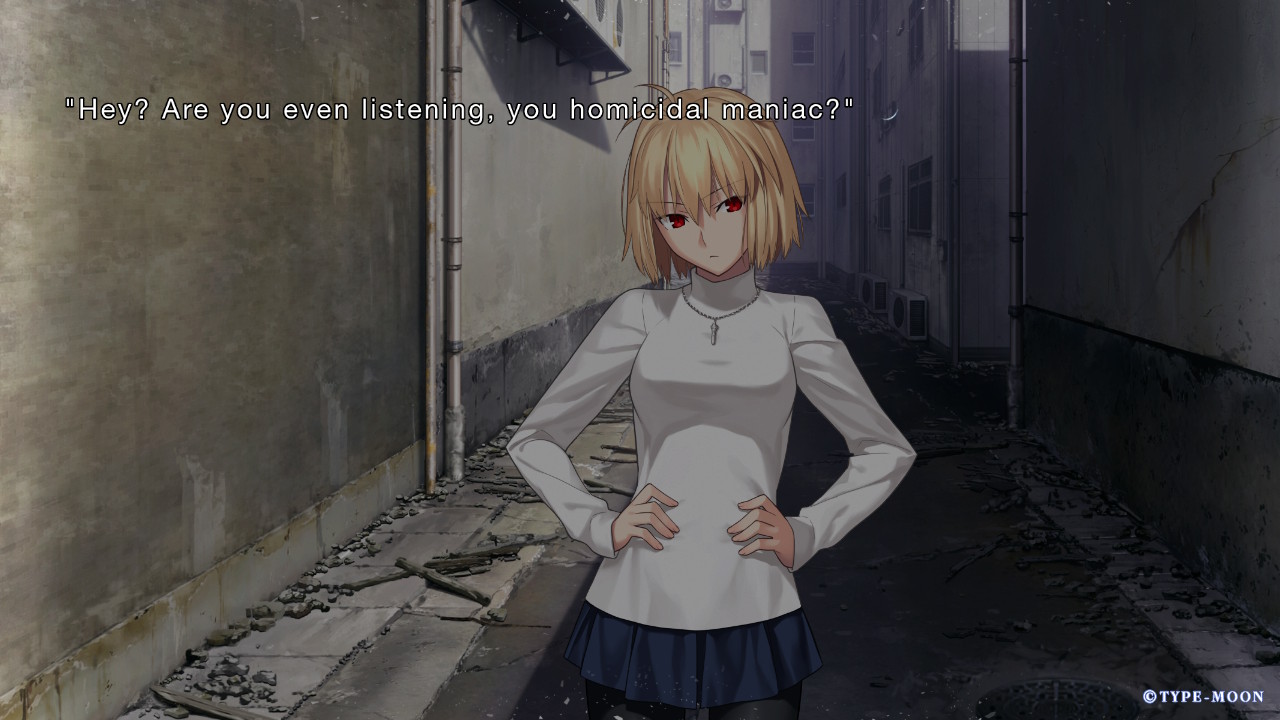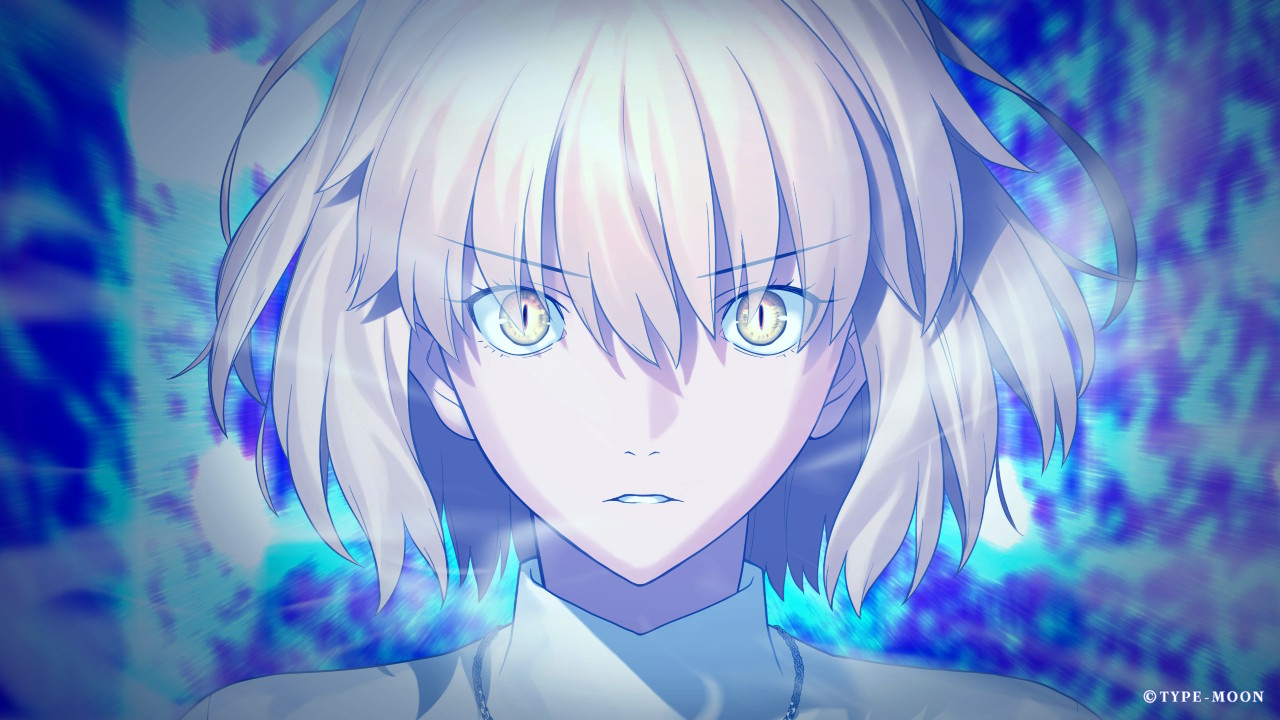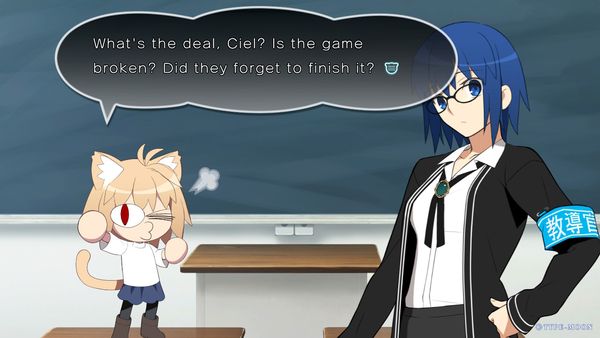System: Switch
Release date: June 27, 2024
Developer: Type-Moon
Publisher: Aniplex
The overwhelming success of Fate/Grand Order in recent years has significantly enhanced Type-Moon’s reputation, and as a long-time fan of their work I couldn’t be happier about it, as it has resulted in a lot of their less mainstream work reaching us overseas. With the surprise Western release of Witch on the Holy Night in 2022, and the release of the critically acclaimed Fate/Stay Night confirmed for Switch in the near future, it’s a welcome surprise that Tsukihime: A Piece of Blue Glass Moon arrives to fill the gap between the two. This also marks the first time the game has been released to western audiences, and although it’s an incomplete package by itself, it’s another exemplary work from the developer that is definitely worth a look.
Shiki Tohno is our protagonist, and events unfold from his perspective. After being involved in a near-fatal accident, Shiki is left physically frail and with the gift (or perhaps the curse) of Mystic Eyes of Death Perception, transforming his vision into a mess of chaotic red lines that show where any object (whether it’s a living being or an inanimate object) can be killed if cut into, another ability he’s picked up as a result of being able to see the lines in the first place. It’s enough to drive anyone insane, but fortunately for Shiki, a chance encounter and a special pair of glasses have allowed him to lead a relatively unremarkable life for the last seven years. Although it is unfortunately one in exile, as his father has banished him from the family home for his weakness, effectively disinheriting him. But with the death of his father, his sister Akiha, the new head of the family, recalls him to live with her. From there Shiki’s normal life is turned upside-down as he becomes involved with (amongst other things) a serial murder case and an eccentric vampire princess, and must come to terms with his own mysterious powers and circumstances.
From there the story unfolds depending upon which route you choose, following either Arcueid, the vampire princess, or Ciel, a classmate of Shiki’s. The two routes share the common route before diverging into their own pathways, with Arcueid’s story having a single ending and Ciel’s having two, making the structure of the narrative feel quite linear overall. At an average reading speed, assuming you read everything and want to explore the numerous bad endings the game has, a playthrough will probably last around forty or fifty hours, making it easily the same length as comparable visual novels on the system, and both tell complete stories independent of one another. There are some ties to Witch on the Holy Night, and fans of Melty Blood: Type Lumina will be instantly familiar with the characters and setting here, but no knowledge of either of those titles is required to get the most out of the game.

It takes time for things to really come together regardless of who you go with, but Tsukihime is excellently paced overall, only slowing down once it gets going during a couple of instances (more noticeably during Arcueid’s route) to set the scene and explain some of its underlying concepts. Even so, it does this in as engaging and entertaining a fashion as possible, taking advantage of this to develop its characters and their interactions with one another. Although there are times when dialogue feels more like a setup for things to come than something relevant to the matter at hand (mostly involving the three characters who will later receive their own routes) Tsukihime never wastes time, and moves its story along at a good speed, balancing action scenes with the typical slice-of-life shenanigans you would expect from teenagers in this kind of setting, even if their situation is a bit bizarre.
Tsukihime adopts a show-and-don’t-tell approach during its more exciting moments that makes it a more immersive experience than you might expect. Rather than drowning you in overly lengthy and flowery descriptions of scenes, the game will pull you right in with dramatic action shots that look as though they were taken straight out of an Ufotable anime, with viscerally satisfying sound effects to accompany them; the game doesn’t want to just tell you about the battle unfolding, it wants you to feel every blow, and it conveys this brilliantly. In critical moments, the presentation of on-screen text becomes notably more chaotic as sentences become shorter, repetitive, or fragmented as the situation demands; quite often all three at once as Shiki struggles to make sense of what is going on around him. It’s difficult not to empathize with Shiki as his exhaustion overcomes him and he is unable to form a complete sentence, or refers to himself in the third person as he becomes more detached from his surroundings. It’s especially effective when you stumble across one of the game’s bad endings, which will often kill Shiki in a sudden, brutal fashion without him even realizing what is happening until it’s too late for him to do anything about it.
Despite this being Shiki’s story there is an element of player choice present in Tsukihime, and quite often you will be called upon to make a decision, with there generally being only one correct answer, and it’s not very often that the game will outright spell out for you what you should do to progress. It’s also surprisingly deceptive: more than once I thought I had made the correct decision, only to be greeted with a sudden bad ending after about twenty minutes of reading, once or twice going into the next chapter. This unpredictability made the game much more engaging and exciting; death could strike at literally any time, and often did.

Some of the best moments in Tsukihime actually come from failure. Making the incorrect decision and meeting your untimely (and often grisly) demise will result in “Teach me, Ms. Ciel!” skits playing, in which Ms. Ciel and Neco-Arc will proceed to tell you exactly what you did wrong and what you should consider doing next time to keep the story moving. Their interactions were the highlight of the entire experience for me, serving as a welcome reprieve from the darker moments in the main story and a reward for taking the time to explore my options, or perhaps a consolation prize for failing in some instances. These are entirely optional, but after the first two I found myself actively making a save and reloading if I made the right choice, just so I could experience the bad ending and the “dubious hint” that followed it.
Despite the excellent quality of what is included, it’s worth noting at this point that you’re not getting the full package with Tsukihime: A Piece of Blue Glass Moon, which only adapts the first two routes of the original visual novel, collectively known as the “Near Side” of the story. The remaining three routes, or “Far Side”, are for Akiha, Hisui, and Kohaku, and will be the focal point of the upcoming Tsukihime: The Other Side of the Red Garden. At time of writing this doesn’t have a release date in Japan let alone a confirmed localization, so this may be something worth keeping in mind if you were hoping for a more complete, or at least well-rounded, experience.
At this point it’s difficult to say just how much has been left out of the story as a whole with these routes excluded, but at times there is a definite sense of a work left unfinished, or at the very least a lot left unsaid. Characters who are clearly of some significance in the grand scheme of things are introduced, and then simply vanish. It’s a tantalizing teaser when you know there is more going on than what is presented, and that knowing what that is would no doubt provide a more complete picture. The worldbuilding in Tsukihime is exceptional, and whenever an important character was introduced only to be forgotten about, any frustration I felt was often born from a desire to know more, rather than a sense that I wasn’t being told enough to get the most out of what was included in the game.

The quality of the localization in Tsukihime is excellent. Although unfortunately (but not unsurprisingly) only Japanese audio is available for voice acting, there are very few typos to speak of, and any awkwardness in grammar or sentence structure is by intent rather than the result of poor translation. I found that this actually made the experience feel more organic, as this only tended to happen when Shiki’s mental state took a turn for the worse, making it a perfect reflection of this. Visually the game has some striking, highly detailed backgrounds that become warped alarmingly whenever Shiki takes off his glasses to reveal the lines of death. Character portraits move and change expressions to fit the scene, although they are not fully animated in the way that many anime-style visual novels are. However, as they are often obscured by text I did not find this to be particularly detrimental overall.
The usual array of accessibility options is present in Tsukihime, allowing you to fast-forward, rewind, and skip text, as well as set the rate at which it appears, although choosing the option to present everything at once results in some odd visual glitches where the text will momentarily appear and disappear whenever the background changes. The game also features a flowchart, although this is perhaps its weakest feature, being extremely small on the Switch’s handheld screen and quite difficult to navigate based on the vague images and descriptions alone. It also doesn’t allow you to rewind to the precise moment of choice, which feels like a feature any choice-based visual novel should include as standard at this point in time. The need to rely on multiple saves is not an uncommon trend in visual novels, but it feels like more could have been done to make the flowchart a more useful feature, rather than a token inclusion for people who prefer a more visual representation of their progress.
The Verdict

Even with the uncertainty of when (or even if) Tsukihime: The Other Side of the Red Garden will release to complete the remake series, Tsukihime: A Piece of Blue Glass Moon is an outstanding visual novel and one that more than justifies a purchase with the two routes available. It’s an engaging, captivating narrative that relies just as much on visual imagery and ambience as it does on text descriptions, and pulls you into its often cruel world in a way that few others can match.
Tsukihime: A Piece of Blue Glass Moon copy provided by the publisher for the purposes of this review.
